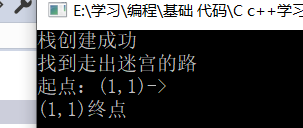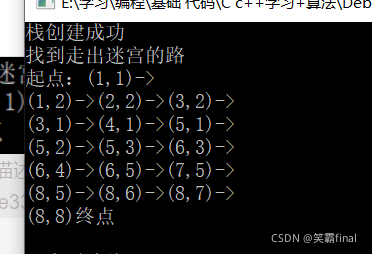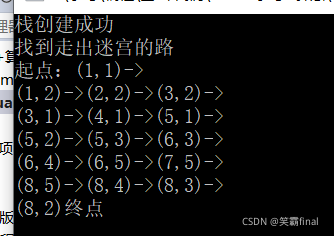一、實(shí)驗(yàn)?zāi)康?/h2>
理解棧的抽象數(shù)據(jù)類(lèi)型定義及操作特點(diǎn)。掌握順序棧的存儲(chǔ)結(jié)構(gòu)的描述。掌握順序棧的基本操作的實(shí)現(xiàn)方法。理解棧的廣泛應(yīng)用。
二、預(yù)備知識(shí)
閱讀課程教材P44~45頁(yè)內(nèi)容,掌握棧的邏輯定義及“后進(jìn)先出”的特點(diǎn),理解抽象數(shù)據(jù)類(lèi)型棧的定義。閱讀課程教材P45~47頁(yè)內(nèi)容,理解順序棧的存儲(chǔ)特點(diǎn)及存儲(chǔ)表示,掌握順序棧各種基本操作(InitStack、StackEmpty、GetTop、Push、Pop等)的實(shí)現(xiàn)方法。閱讀課程教材P50~52頁(yè)內(nèi)容,理解“迷宮求解”問(wèn)題的含義,體會(huì)求解過(guò)程中棧的應(yīng)用。仔細(xì)分析主要實(shí)現(xiàn)算法,理解求解步驟和方法。
三、實(shí)驗(yàn)內(nèi)容
按如下要求編寫(xiě)程序,進(jìn)行調(diào)試,寫(xiě)出調(diào)試正確的源代碼,給出測(cè)試結(jié)果。
1.完成順序棧的存儲(chǔ)表示,實(shí)現(xiàn)順序棧的各種基本操作,包括InitStack、StackEmpty、GetTop、Push、Pop等操作。
2.利用順序棧求解迷宮中從入口到出口的一條路徑,并輸出結(jié)果。
說(shuō)明:
(1)使用二維數(shù)組maze描述迷宮,迷宮的規(guī)模及初態(tài)自定。
(2)路徑的輸出形式可用文字描述,也可用圖形描述。
定義一些代碼:
#include<iostream>
#include<cstdlib>
#define STACK_INIT_SIZE 100
#define STACKINCREMENT 10
typedef struct {//棧元素類(lèi)型
int x;//坐標(biāo)
int y;//坐標(biāo)
int di;//方向
}position;
using namespace std;
typedef struct {//棧
position *base;
position *top;
int stacksize;
}Stack;
/*************************迷宮**********************************/
int Maze[10][10] = {//迷宮 Maze(妹子)原型如下圖:1表示路不通0表示可以通過(guò)。
// 0 1 2 3 4 5 6 7 8 9
{1,1,1,1,1,1,1,1,1,1},//0
{1,0,0,1,0,0,0,1,0,1},//1
{1,0,0,1,0,0,0,1,0,1},//2
{1,0,0,0,0,1,1,0,0,1},//3
{1,0,1,1,1,0,0,0,0,1},//4
{1,0,0,0,1,0,0,0,0,1},//5
{1,0,1,0,0,0,1,0,0,1},//6
{1,0,1,1,1,0,1,1,0,1},//7
{1,1,0,0,0,0,0,0,0,1},//8
{1,1,1,1,1,1,1,1,1,1} //9
};

定義類(lèi)
class boos {//創(chuàng)建了一個(gè)角色類(lèi)
private:
Stack sq_stack;//棧
position temp;
public:
/******************************棧的基本方法*******************/
void InitStack() {//創(chuàng)建棧
bool StackEmpty()//判斷是否空棧
bool GetTop(position &temp)//獲得棧頂
bool Push(position &temp)//入
bool Pop(position &temp)//出棧
void free_Stack()//釋放棧空間
/******************************走迷宮方法*******************/
bool findMaze(int star_x, int star_y, int endr_x, int end_y)
//迷宮的入口和出口坐標(biāo)
};
類(lèi)的成員函數(shù)的一些說(shuō)明:
這是一些基礎(chǔ)方法 用于對(duì)棧的操作。
void InitStack() {//創(chuàng)建空的棧
sq_stack.base = (position *)malloc(sizeof(Stack)*STACK_INIT_SIZE);
if (!sq_stack.base) exit(-1);
sq_stack.top = sq_stack.base;/*FHL*/
sq_stack.stacksize = STACK_INIT_SIZE;
cout << "棧創(chuàng)建成功" << endl;
}
bool StackEmpty() {判斷是否空棧
if (sq_stack.top == sq_stack.base)return 1;
else
return 0;
}
bool GetTop(position &temp) {//得到棧頂元素
if (StackEmpty())return false;
temp= *(sq_stack.top-1);
return true;
}
bool Push(position &temp){//入棧/*FHL*/
if (sq_stack.top - sq_stack.base >= sq_stack.stacksize) {
sq_stack.base = (position*)realloc(sq_stack.base
sizeof(position)*(sq_stack.stacksize + STACKINCREMENT));
if(!sq_stack.base) exit(-1);/*FHL*/
sq_stack.top = sq_stack.base + sq_stack.stacksize;
sq_stack.stacksize += STACKINCREMENT;
}
*sq_stack.top = temp;
sq_stack.top++;
return true;
}
bool Pop(position &temp) {//出棧
if (StackEmpty()) return 0;
sq_stack.top--;
temp = *sq_stack.top;
return 1;
}
void free_Stack() {
free(sq_stack.base);
}
找迷宮的方法(dfs算法)
bool findMaze(int star_x, int star_y, int endr_x, int end_y) {//迷宮的入口和出口坐標(biāo)
int i, j, k = 0;//i j表示目前的坐標(biāo)
int tep_di,next_x,tep_y;//下一步的坐標(biāo)
bool flag;
position fan_maze[200];
InitStack();//先創(chuàng)建空棧
temp.x = star_x, temp.y = star_y, temp.di - 1;//開(kāi)始位置
Push(temp);//入棧操作。/*FHL*/
Maze[star_x][star_y]=-1;//-1表示走過(guò);
while (!StackEmpty()) {//棧不為空
GetTop(temp);/*FHL*/
i = temp.x, j = temp.y , tep_di=temp.di;
if (i == endr_x && j == end_y) {
cout << "找到走出迷宮的路" << endl;
k = 0;
while (!StackEmpty()) {
Pop(temp);
fan_maze[k] = temp;
k++;//k指向下一個(gè)被插入的位置;
}
cout <<"起點(diǎn):"<< "(" << fan_maze[k-1].x << "," << fan_maze[k-1].y << ")->" << endl;
int count = 1;
for(k-=2;k>0;k--) {
cout<<"(" << fan_maze[k].x <<","<< fan_maze[k].y<<")->";
if (count % 3 == 0) cout << endl;
count++;
}
cout << "(" << fan_maze[0].x << "," << fan_maze[0].y << ")" << "終點(diǎn)" << endl;//出口的位置
free_Stack();//釋放申請(qǐng)的堆空間
return true;
}/*FHL*/
flag = 0;
while (tep_di < 4 && !flag) {
tep_di++;
if (tep_di == 0){ next_x = i; tep_y = j + 1;}
else if (tep_di == 1) { next_x = i + 1;tep_y = j; }
else if (tep_di == 2) { next_x = i;tep_y = j - 1; }
else { next_x = i - 1; tep_y = j; }
if( Maze[next_x][tep_y] == 0 ) flag = 1;
}
if(flag) {
(sq_stack.top-1)->di = tep_di;//記錄上次坐標(biāo)走的方向。
temp.x = next_x, temp.y = tep_y,temp.di=-1;
Push(temp);//這次坐標(biāo)入棧
Maze[next_x][tep_y] = -1;//當(dāng)前坐標(biāo)標(biāo)記為走過(guò)。
}
else {
Pop(temp);
Maze[temp.x][temp.y] = 0;
}
}/*FHL*/
cout << "沒(méi)有找到對(duì)應(yīng)的出口" << endl;
free_Stack();//釋放申請(qǐng)的堆空間
return false;
}
};
主函數(shù)(創(chuàng)建對(duì)象)
int main() {
boos L1;
L1.findMaze(1,1,8,8);
system("pause");/*FHL*/
return 0;
}
運(yùn)行的一些截圖:
1.當(dāng)入口和終點(diǎn)一樣時(shí):
int main() {
boos L1;
L1.findMaze(1,1,1,1);
system("pause");
return 0;
}

2.終點(diǎn)是可以到達(dá)的路徑
2.1(8,8)是終點(diǎn)
int main() {
boos L1;
L1.findMaze(1,1,8,8);
system("pause");
return 0;
}

2.2(8,2)是終點(diǎn)
int main() {
boos L1;
L1.findMaze(1,1,8,2);
system("pause");
return 0;
}

3.出口不通的情況
int main() {
boos L1;
L1.findMaze(1,1,9,9);
system("pause");
return 0;
}

以上就是C++數(shù)據(jù)結(jié)構(gòu)關(guān)于棧迷宮求解示例的詳細(xì)內(nèi)容,更多關(guān)于C++數(shù)據(jù)結(jié)構(gòu)棧迷宮的資料請(qǐng)關(guān)注服務(wù)器之家其它相關(guān)文章!
原文鏈接:https://blog.csdn.net/weixin_52062043/article/details/121062726














